Principal Gods and Goddesses of the Greek Mythology
- Franchesca Santiago
- Jul 31, 2020
- 7 min read
Updated: Aug 2, 2020
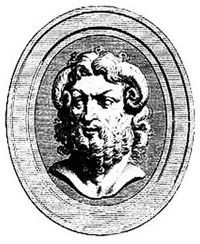
Zeus is the king of the gods and ruler of Mount Olympus. He is the god of lightning, thunder, law and order and justice. He was the youngest child of the Titans Cronus and Rhea and is husband and brother of Hera. He was known to have had many lovers including mortal women by whon he sired many children. His symbols are the thunderbolt, eagle, lion and scales.
Zeus was the king of the hill. He was dominating, powerful and had a soft spot for pretty women. He could be terrifying when angry. His symbols were the thunderbolts, or lightning bolts made for him by the Cyclopes (his uncles); the eagle; and the scepter, or rod. Please copy this information onto your chart
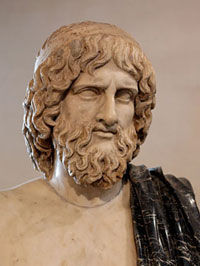
Hades, or Pluto, was the god of the underworld and of the dead. He was called the same names by the Romans, but they also sometimes called him Dis or Dis Pater. He was Zeus's brother and married Persephone after kidnapping her against her will. He was gloomy and frightening.
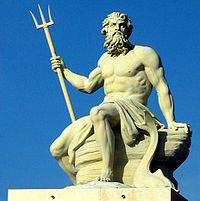
Next, we have Poseidon, or Neptune, as the Romans called him. He was Zeus's brother, and he was the god of the sea and also earthquakes. He often is shown with a three-pronged spear called a trident that was made for him by his nephew, Hephaestus, and/or a fish.
Poseidon was god of the sea and the most powerful god except for his brother, Zeus. He was known as the protector of all waters and sailors relied upon him for safe passage. He lived in a beautiful palace under the sea and caused earthquakes when he was in a bad temper.

Our first goddess is Hera. She sits on the right side of Zeus and is his wife. Of course, she's his sister, too, but that's the way it was on Olympus. Hera's Roman name is Juno, and she is the queen of the gods. She is the guardian of marriage and was well-loved by the Greeks; it's kind of sad that she's the goddess of marriage but her own marriage was so bad. She was often jealous of her husband's girlfriends and did mean things to them, even the ones who didn't want anything to do with him, but she could be tender and loving as well. The peacock was her symbol. In fact, the circles in a peacock's tail are said to be the eyes of her 100-eyed servant, Argus.
She was raised by the Titans Ocean and Tethys. She is the queen of the gods and protector of marriage, childbirth and family, and takes special care of married women. But despite this, she was known to be jealous and vengeful towards the many lovers and offspring of her husband Zeus. Her symbols include the peacock, cuckoo and cow.

Next is Athena, or Minerva, the daughter who sprang fully formed from the head of Zeus after a major headache. She is the goddess of wisdom and war and also the protector and namesake of the city of Athens. She preferred reason to violence unless she was pushed. She turned Arachne into a spider for bragging that she could spin better than Athena. She was very competitive and is often pictured with her helmet and a spear. She carried Zeus's shield, called the aegis. The owl was her bird. Can you see it in her hand?
Athena was the goddess of reason, wisdom, knowledge, defence and strategic warfare. She was reportedly born from Zeus’ head, fully grown and in full body armour. A major figure in the Odyssey, her main temple in Athens bears her name: The Parthenon. The owl and the olive tree are her symbols.
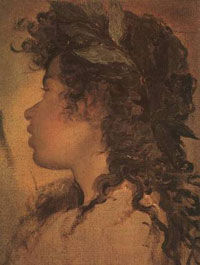
Apollo was a twin. His Roman name was the same as his Greek name. He was the god of the sun or light, poetry, music and medicine and was famous for his oracles (wise women to whom he gave his power to predict and interpret the future). He was very proud and also protective of his mother and sister. His symbols were the gold bow and arrows, and he often appears golden and shining. He wears a laurel wreath in memory of Daphne, who didn't want to be his lover and prayed to Mother Earth for help escaping him; she was turned into a laurel tree.
Apollo, is one of the most versatile gods in the Greek Pantheon. He is the god of music, poetry, art, medicine, knowledge and is linked to the sun. His appearance is impeccable: a beardless, athletic and youthful figure. His symbol is the lyre.
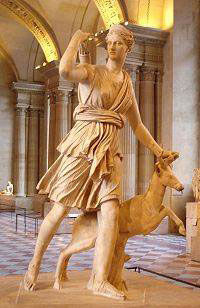
Artemis was Apollo's twin. Her Roman name was Diana, and she was the goddess of hunting, chastity and the moon. She protects women and small children, is fiercely independent and particularly dislikes men. In pictures, she is seen accompanied by three hunting hounds, a bow and a fawn.
Artemis is the daughter of Zeus and Leto and her twin brother is Apollo. She emerged as the virgin goddess, the goddess of the hunt, the wilderness, archery, and the protector of the young. She also presides over childbirth as her own mother bore her without any pain. Her symbols include the moon and the deer.
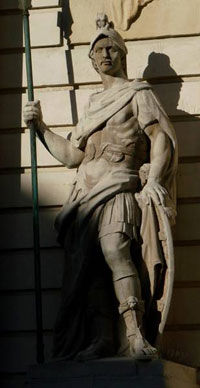
Ares or, as he is known by his Roman name, Mars, was the god of war. He would fight on both sides, if possible. He was young, strong and handsome, and liked to dress in battle clothes even when he wasn't fighting.
Ares was the god of war, bloodshed and manly virtues. He was the son of Zeus and Hera. From his Latin name Mars, came the name of martial arts. He was disliked by all the other gods. His symbols include the boar, serpent, vulture, spear and shield.
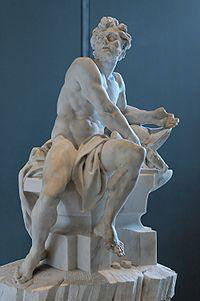
Hephaestus, or Vulcan, was born lame and was further crippled when he was thrown from Olympus by his mother, Hera, in a rage. He was the only Olympian with a disability. He was unhappily married to Aphrodite and worked as a blacksmith in the gods' forge.
Hephaestus is the God of fire, master blacksmith and craftsman of the gods..He is the son of Hera, produced by her without a father, in a show of independence. It is said that Hephaestus was born lame, and disgusted, Hera threw him down from Mount Olympus into the sea where he was brought up by sea goddesses Eurynome and Thetis. He was the husband of Aphrodite. His symbols are fire, the anvil, axe, hammer and quail.
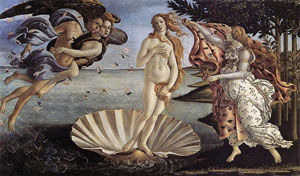
Hephaestus's wife, Aphrodite, whose Roman name was Venus, was the goddess of love and beauty. She was born out of sea foam when the blood of Uranus dropped into the ocean. She was the mother of Eros and was irresistibly charming, fickle, vain and competitive. Her symbol was a cestus, or magic belt, that made everyone fall in love with the wearer; sometimes she would lend it to humans. This is a famous painting of the birth of Venus, or Aphrodite, by Botticelli.
Aphrodite was the Olympian goddess of love, beauty, pleasure, passion, fertility, desire and procreation. Depicted as always beautiful, she was accompanied by the winged god Eros (Love), while in classical sculpture she was usually depicted nude.
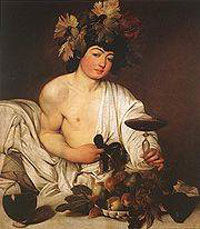
Dionysus was the partier of the mountain retreat. He was Zeus's son by another woman, who was driven crazy by Hera and her jealousy. Dionysus went all around teaching people how to make wine and having a good time. Eventually, Hestia gave up her throne for him, and he lived on Olympus. He was the god of wine, of course, and also vegetation.
Dionysus was raised by mountain nymphs and that is how he allegedly discovered how to make wine from grape. He is the god of wine, fertility, festivity, ecstasy, madness and resurrection. He is the patron god of theatre. He is also interestingly portrayed both as youthful and as an older man with a beard. He is the youngest god of the Olympians and the only one to have had a mortal mother. His symbols include the grapevine, ivy, and cup among others.

Hermes, or Mercury, was the god of science and invention, but he is best known as the messenger of the gods. He is often pictured with a winged helmet and sandals. He is said to have invented the alphabet, boxing and gymnastics! In this painting by Goltzius, you can see his helmet with wings; he's not wearing his famous sandals, though.
Hermes was the messenger of the gods. He is the god of commerce, travel, communication, eloquence, diplomacy and games. His symbols include the caduceus (staff entwined with two snakes), winged sandals, stork and tortoise.
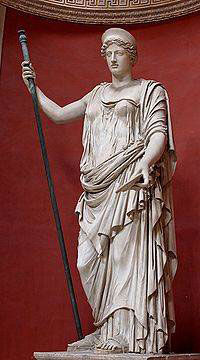
Demeter was the goddess of the crops and the harvest. She is also known as Ceres (Roman) and sometimes Deo. Her symbols include a torch, a crown, a scepter and stalks of grain. She is often portrayed with her daughter, Persephone, who was kidnapped by Hades and taken to the underworld. By the time she was rescued, she'd eaten six pomegranate seeds, so she couldn't escape the underworld entirely. Her mother was so frantic that winter draped the land and no crops would grow. A deal was struck, and Persephone was allowed to return to her mother for half of the year. So each year, when she returns to the underworld, fall comes, then winter — but when she returns to her mother, spring and summer come again.
Demeter was the goddess of agriculture, grain and harvest, nature and the seasons. She is perhaps best known as the mother of Persephone by Zeus. What is notably known is that when Persephone was abducted by Hades and taken to his underworld kingdom, Demeter wandered the earth day and night in search of her. The earth became barren through her neglect; thus, the winter season and its manifestations were a reflection of Demeter’s emotional state during Persephone’s absence. Hades eventually relented and allowed Persephone to be with her mother during the spring and summer seasons. Among Demeter’s symbols are wheat and the cornucopia.

Hestia was Zeus's sister and the goddess and protectress of hearth and home. She is also known by her Roman name, Vesta. She was gentle and kind and was very popular with the Greeks. She didn't have a lot of adventures, so she's rarely pictured in art.
Hestia is also included in the Olympian Pantheon. She was the goddess of the hearth, home, architecture, domesticity, family, and the state. Both Poseidon and Apollo wanted to marry her, but Hestia made an oath to Zeus that she would remain forever pure and undefiled, never entering into a union with a man. She represented communal security and personal happiness.

ACTIVITY PAGE





Comments